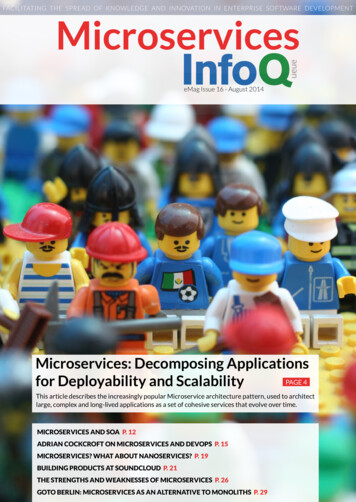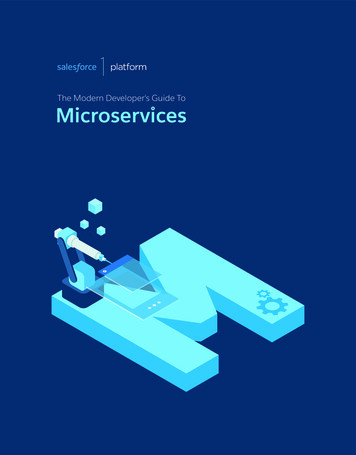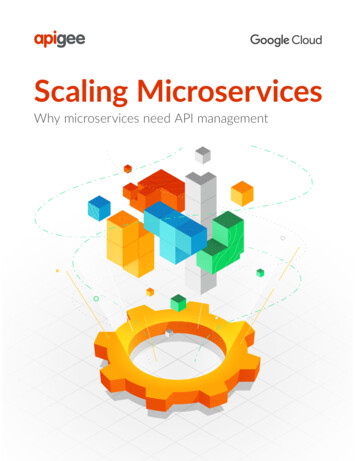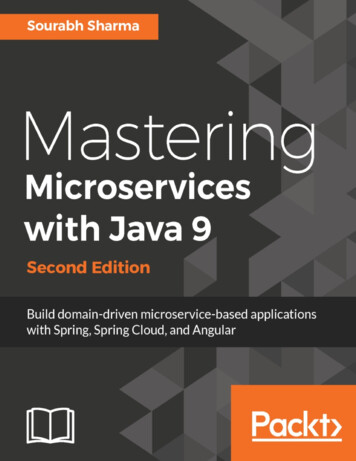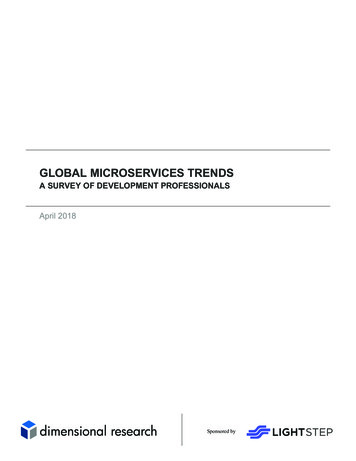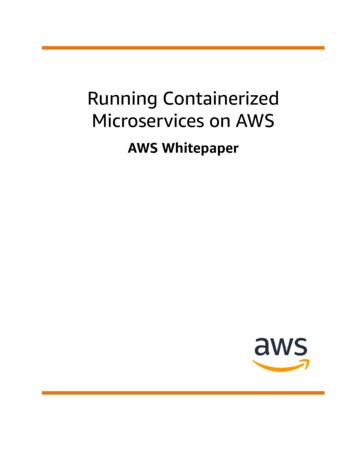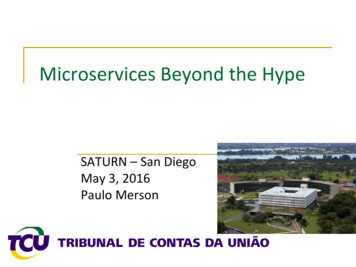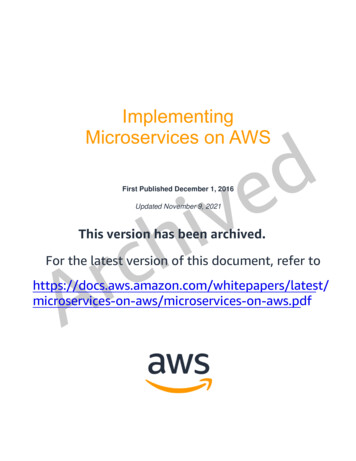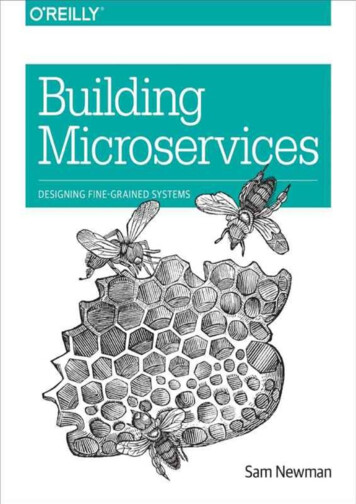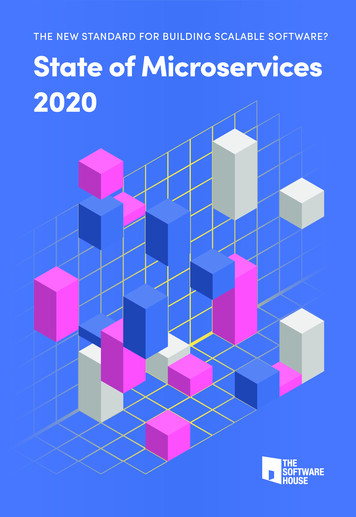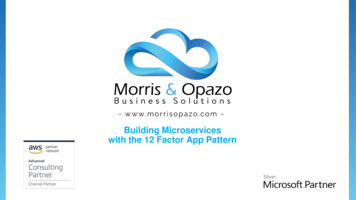
Transcription
Building Microserviceswith the 12 Factor App Pattern
We Add Value to your BusinessContextThis documentation will help introduce Developers to implementing MICROSERVICES by applying the TWELVEFACTOR PRINCIPLES, a set of best practices and methodology for a well-formed architecture, enforcing AGILEconcepts and favoring SCALABILITYwww.morrisopazo.com / contacto@morrisopazo.comChicago - Antofagasta - Temuco - Santiago
We Add Value to your BusinessBenefits of Microservices AGILITY, small independent teams take ownership of their services, workindependently and quickly (shortening cycle times). INNOVATION, small teams can act autonomously and choose theappropriate technologies, frameworks, and tools for their domains. QUALITY, improved reusability, composability, and maintainability of code. SCALABILITY, Properly decoupled services can be scaled horizontally andindependently from each other. The scaling process can be completelyautomated. AVAILABILITY, easier to implement failure isolation, reduce the blast radiusof a failing component and improve the overall availability of a givenapplication.www.morrisopazo.com / contacto@morrisopazo.comChicago - Antofagasta - Temuco - Santiago
We Add Value to your BusinessPrinciples of Microservices DECENTRALIZED, Distributed systems with decentralizedmanagement, development, deployment, and operation.microservice has its own view on data models.dataEach INDEPENDENT, Different components can be changed, upgraded, orreplaced independently without affecting the functioning of othercomponents. Teams are enabled to act independently from each other. DO ONE THING WELL, Each component is designed for a set of capabilitiesand focuses on a specific domain. POLYGLOT PERSISTENCE AND PROGRAMMING, Heterogeneous approachto operating systems, programming languages, data stores, and tools. BLACK BOX, Individual components hide the details of their complexityfrom other components. YOU BUILD IT, YOU RUN IT, The team responsible for building a service isalso responsible for operating and maintaining it in production.www.morrisopazo.com / contacto@morrisopazo.comChicago - Antofagasta - Temuco - Santiago
We Add Value to your BusinessThe Twelve FactorsThese factors serve as an excellent introduction to the discipline ofbuilding and deploying applications in the cloud and preparing teamsfor the rigor necessary to build a production pipeline aroundelastically scaling applications.This methodology helps to build software-as-a-service applications.www.morrisopazo.com / contacto@morrisopazo.comChicago - Antofagasta - Temuco - Santiago
We Add Value to your BusinessThe Twelve Factors1) Codebase7) Port binding2) Dependencies8) Concurrency3) Config9) Disposability4) Backing services10) Dev/prod parity5) Build, release, run11) Logs6) Stateless Processes12) Admin processeswww.morrisopazo.com / contacto@morrisopazo.comChicago - Antofagasta - Temuco - Santiago
We Add Value to your Business1) Codebase“One codebase tracked in revision control, many deploys” One Codebase, Multiple Deploys ANTI-PATTERN, There must be a change to thecodebase to deploy to a specific environment. ANTI-PATTERN, Multiple apps sharing the samecode.SOLUTION Factor shared code into libraries whichcan be included through a Dependency Manager. Code is managed in a distributed source controlsystem such as Git One Codebase One App Codebase repo One repo many deploys App ! Many Repos Many Repos Distributed Systemwww.morrisopazo.com / contacto@morrisopazo.comChicago - Antofagasta - Temuco - Santiago
We Add Value to your Business2) Dependencies“Explicitly declare and isolate dependencies” DEPENDENCY MANAGER as Maven, we explicitly manage dependenciesin a pom.xmlDEPENDENCY DECLARATION (pom.xml) DEPENDENCY DECLARATION, Specify all dependencies via a DependencyDeclaration Manifest. Specific versions are important CENTRAL BUILD ARTIFACT REPOSITORY such as Jfrog Artifactory, thisensures that the versions are managed correctly DEPENDENCY ISOLATION, Never depend on the host to have yourdependency. Application deployments should carry all theirdependencies with them.www.morrisopazo.com / contacto@morrisopazo.comChicago - Antofagasta - Temuco - Santiago
We Add Value to your Business3) Config“Store config in the environment” Externalization of all configuration parameters from the code. No configin git. An application's configuration parameters vary between environments. Microservices configuration parameters should be loaded from anexternal source Protect sensitive configuration information (encrypt config settings). Application configuration data is read during service bootstrapping phase. Codebase could be made open source at any moment, withoutcompromising any credentials. Use environment varswww.morrisopazo.com / contacto@morrisopazo.comChicago - Antofagasta - Temuco - Santiago
We Add Value to your Business4) Backing Services“Treat backing services as attached resources” All backing services should be accessible through an addressable URL, withoutcomplex communication requirements. Make no distinction between local and third party services. Keep Environment Consistence. Examples:- Datastores- Messaging/Queueing Systems- SMTP services- Caching system- Third-Party APIs.www.morrisopazo.com / contacto@morrisopazo.comChicago - Antofagasta - Temuco - Santiago
We Add Value to your Business5) Build, Release, Run“Strictly separate build and run stages” Strong isolation between Build, Release, and Run:- Build Stage, compiling and producing binaries by including all the assets required.- Release Stage, combining binaries with environment- specific configuration parameters.- Run Stage, running application on a specific execution environment. The pipeline is unidirectional, so it is not possible to propagate changes from the run stagesback to the build stage. ANTI-PATTERN, Specific builds for production.SUGGESTION Go through the pipeline. ANTI-PATTERN, Make changes to the code at runtime.SUGGESTION Any change (or set of changes) must create a new release, following thePipeline: Build - Release - Run. SUGGESTION Every release should always have a unique release ID, such as a timestamp ofthe release (such as 2011-04-06-20:32:17) or an incrementing number (such as v100).www.morrisopazo.com / contacto@morrisopazo.comChicago - Antofagasta - Temuco - Santiago BUILD codebase dependencies assets RELEASE BUILD config RUN run process against RELEASE ROLLBACK just use the last release instead.
We Add Value to your Business5) Build, Release, Runwww.morrisopazo.com / contacto@morrisopazo.comChicago - Antofagasta - Temuco - Santiago
We Add Value to your Business6) Stateless Processes“Execute the app as one or more stateless processes” SUGGESTION, Processes are stateless and share-nothing. Any data that needs topersist must be stored in a stateful backing service. ANTI-PATTERN, To assume that anything cached in memory or on disk will beavailable on a future request or job. ANTI-PATTERN, “sticky sessions”.SUGGESTION, Session state data (a datastore that offers time-expiration, such asMemcached or Redis). They can be killed and replaced at any time without the fear that a loss-of-aservice instance will result in data loss. Microservices should always be stateless.www.morrisopazo.com / contacto@morrisopazo.comChicago - Antofagasta - Temuco - Santiago
We Add Value to your Business7) Port binding“Export services via port binding” Port binding is one of the fundamental requirements formicroservices to be autonomous and self-contained. Microservices embed service listeners as a part of the serviceitself. You should run the service without the need for a separated webor application server.www.morrisopazo.com / contacto@morrisopazo.comChicago - Antofagasta - Temuco - Santiago
We Add Value to your Business8) Concurrency“Scale out via the process model” When you need to scale, launch more microservice instances:- Microservices should be designed to scale out by replicating.- Microservices should be designed to scale horizontally ratherthan vertically. AUTO-SCALINGThe services can be elastically scaled or shrunk based on givenmetric. Threading can be used within microservices, but don’t rely onit as the sole mechanism for scaling.www.morrisopazo.com / contacto@morrisopazo.comChicago - Antofagasta - Temuco - Santiago
We Add Value to your Business9) Disposability“Maximize robustness with fast startup and graceful shutdown” Microservices are disposable, can be started or stopped at any moment. Startup time should be minimized and microservices should shut downgracefully when they receive a kill signal. In an automated deployment environment, we should be able bring up or bringdown microservice instances as quick as possible. It is extremely important to keep the size of the application as thin as possible,with minimal startup and shutdown time. Be robust against sudden death. Replace crashed processes faster.www.morrisopazo.com / contacto@morrisopazo.comChicago - Antofagasta - Temuco - Santiago
We Add Value to your Business10) Dev/Prod Parity“Keep development, staging, and production as similar as possible” The twelve-factor app is designed for continuous deployment bykeeping the gap between development and production small. Minimize the gaps that exist between all of the environments inwhich the service runs. As soon as code is committed, it should be tested and thenpromoted as quickly as possible from Dev all the way to Prod. ANTI-PATTERN, In a development environment, run allmicroservices on a single machine, whereas in productionindependent machines run each one. If production fails, there is noidentical environment to reproduce and fix the issues.Traditional appTwelve-factor appTime between deploysWeeksHoursCode authors vs codedeployersDifferentpeopleSame peopleDev vs productionenvironmentsDivergentAs similar as possiblewww.morrisopazo.com / contacto@morrisopazo.comChicago - Antofagasta - Temuco - Santiago
We Add Value to your Business11) Logs“Treat logs as event streams” Logs are a stream of events. ANTI-PATTERN, Attempt to write to or manage log files.SUGGESTION, Ship logs to a central repository by tapping the logbackappenders and write to one of the shippers' endpoints. Log correlation: All service log entries have a correlation ID that tiesthe log entry to a single transactionwww.morrisopazo.com / contacto@morrisopazo.comChicago - Antofagasta - Temuco - Santiago
We Add Value to your Business12) Admin Processes“Run admin/management tasks as one-off processes” Use the same release bundle as well as an identical environment for bothapplication services and admin tasks. Admin code should be packaged along with the application code. Admin tasks should never be ad hoc and instead should be done via scriptsthat are managed and maintained through the source code repository. Admin scripts should be repeatable and non-changing across eachenvironment they’re run against.www.morrisopazo.com / contacto@morrisopazo.comChicago - Antofagasta - Temuco - Santiago
We Add Value to your BusinessInter-Process Communication in aMicroservices Architecturewww.morrisopazo.com / contacto@morrisopazo.comChicago - Antofagasta - Temuco - Santiago
We Add Value to your risopazo.com / contacto@morrisopazo.comChicago - Antofagasta - Temuco - Santiago
We Add Value to your BusinessAsynchronous Microservices Communication through Eventswww.morrisopazo.com / contacto@morrisopazo.comChicago - Antofagasta - Temuco - Santiago
We Add Value to your BusinessMicroservices Infrastructure Automationwww.morrisopazo.com / contacto@morrisopazo.comChicago - Antofagasta - Temuco - Santiago
We Add Value to your BusinessReferences The Twelve-Factor App: https://12factor.net/ Microservices on ws.pdf Beyond the Twelve-Factor App (Kevin Hoffman) Spring Microservices (Rajesh RV) Microservice Architecture (Irakli Nadareishvili, Ronnie Mitra, Matt McLarty & Mike Amundsen) Kubernetes Microservices with Docker (Deepak Vohra) Spring Microservices in Action (John Carnell) Spring Boot Messaging (Felipe Gutierrez)www.morrisopazo.com / contacto@morrisopazo.comChicago - Antofagasta - Temuco - Santiago
Find out more at¡Visit our Web Site!contacto@morrisopazo.comUSA - CHILE
We Add Value to your Business www.morrisopazo.com / contacto@morrisopazo.com Chicago - Antofagasta - Temuco - Santiago This documentation will help introduce Developers to implementing MICROSERVICES by applying the TWELVE- FACTOR PRINCIPLES, a set of best practices and methodology for a well-formed architecture, enforcing AGILE concepts and favoring SCALABILITY


